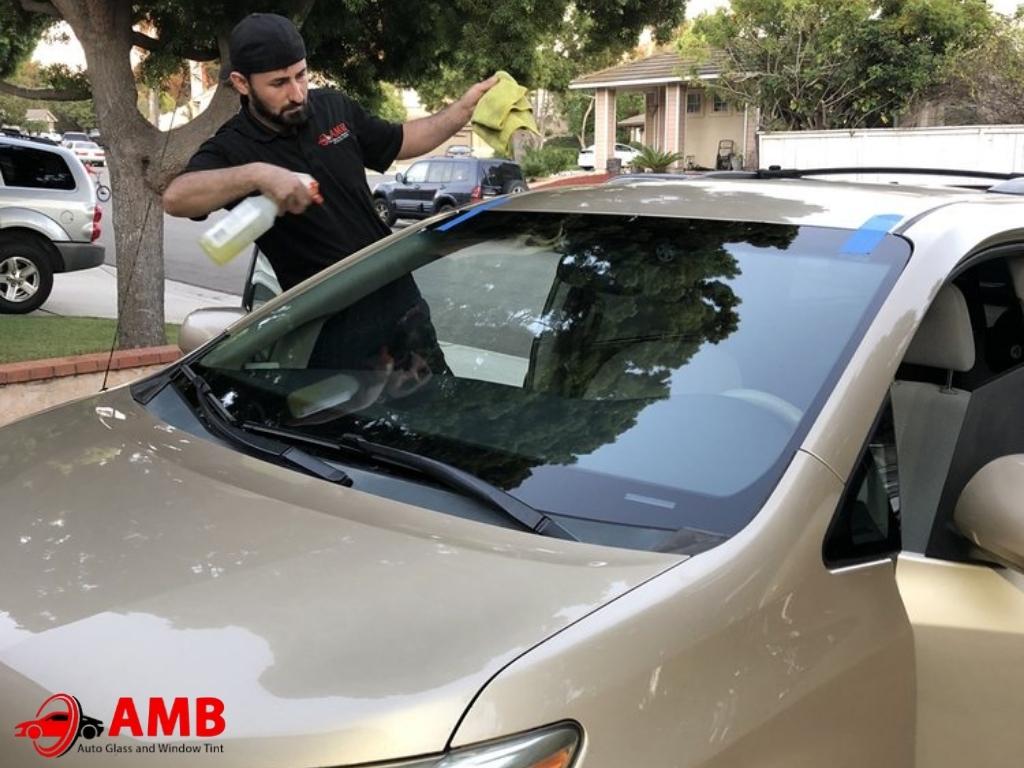For both individual car owners and those managing commercial fleets, the ability to spot and interpret the signs of window damage is invaluable.
This guide navigates through the essential knowledge needed to inspect car windows like a pro, It focuses on early detection techniques to prevent small issues from escalating into significant problems, allowing you to dentify the signs your car window needs replacement.
Common Types of Window Damage
Common damages to car windows that can compromise safety and the vehicle’s structural integrity include:
-
Cracks and Chips: Even small cracks or chips can weaken the vehicle’s structural integrity, reducing its ability to withstand impact, indicating signs your car window needs replacement. Cracks can also spread over time, obstructing the driver’s view and increasing the risk of shattering.
-
Scratches: While scratches may seem minor, they can refract light and cause glare, reducing visibility, especially in bright sunlight or at night, affecting the driver’s vision significantly.
-
Hazing or Fogging: Internal fogging or hazing can occur due to leaks or damage to the auto glass can lead to internal damage, fogging, and even structural weakening of the window frame, necessitating auto glass repairs. This can obstruct visibility, making it difficult to see clearly through the window.
-
Discoloration: Discoloration of the glass can occur due to exposure to sunlight and environmental factors. This can affect the clarity of vision and compromise safety, especially in extreme weather conditions.
-
Loose or Damaged Seals: Seals around the windows can deteriorate over time, allowing water and debris to penetrate. This can lead to internal damage, fogging, and even structural weakening of the window frame.
-
Delamination: In laminated glass windows, delamination occurs when the layers of glass separate, compromising the strength and integrity of the window.
-
Power Window Malfunctions: Issues with power windows can pose safety risks, such as windows getting stuck in the open or closed position, which can be a hazard during emergencies or accidents, underlining the importance of professional auto glass repair.
-
Sunroof Damage: Damaged or malfunctioning sunroofs can lead to leaks, which can cause water damage to the interior of the car and compromise the structural integrity of the roof.
Addressing these damages promptly through regular inspection and professional auto glass repair is crucial to ensuring the safety of both the driver and passengers on the road.
Signs of Hidden Damage
Signs of hidden damage in car windows may not always be immediately apparent, but there are several indicators to watch for:
-
Hairline Cracks: Hairline cracks are tiny fractures in the glass that may not be immediately visible but can spread over time, indicating signs your car window needs replacement to maintain the vehicle’s safety and protect against UV rays. Look for faint lines or patterns on the surface of the glass, especially in areas where there has been impact or stress, as these signs typically indicate the need for repair.
-
Delamination: Delamination occurs when the layers of laminated glass separate, resulting in visible bubbles, spots, or areas of discoloration between the layers. This can weaken the structural integrity of the window and compromise its ability to withstand impact.
-
Fogging or Hazing: Internal fogging or hazing of the glass, often due to a leak or damaged seal, can lead to impaired visibility and suggest the need for professional auto glass repair. While this may not be immediately visible, fogging can occur over time and impair visibility, particularly in humid or damp conditions.
-
Strange Noises: Unusual sounds, such as clicking, rattling, or squeaking, when operating the windows may indicate underlying damage or mechanical issues. These sounds can occur due to loose components, worn-out seals, or damage to the window mechanism.
-
Water Leaks: Water entering the vehicle through the windows during rain or car washes is a clear sign of damaged auto glass or faulty seals, often leading to the complete replacement of the window. Even if the source of the leak is not immediately visible, water stains or dampness on the interior surfaces of the vehicle can indicate hidden damage.
-
Visible Condensation: Condensation forming between the layers of laminated glass or on the interior surface of the window can indicate a seal failure or leak. While condensation may not always be visible, especially in dry climates, it can indicate underlying issues with the window.
-
Sudden Changes in Visibility: Any sudden changes in visibility or clarity through the window, such as distorted images, blurred vision, or sudden changes in light transmission, may indicate hidden damage. These changes can occur due to stress fractures, internal defects, or deterioration of the glass over time.
-
Discoloration: Discoloration of the glass, particularly along the edges or corners, can indicate stress or damage to the window. Look for areas where the glass appears darker, cloudy, or discolored, as these may be signs of hidden damage.
By being vigilant and attentive to these signs, car owners can detect hidden damage in their windows early and address it promptly with auto glass repairs to prevent further deterioration and ensure the safety and integrity of their vehicle.
Tools Needed for Inspection
Certain tools needed to identify window damage. Each of their uses are also detailed below:
-
Microfiber Cloth: A soft and lint-free cloth used to clean the surface of the window before inspection. It helps remove dirt, grime, and debris that may obscure visibility and hide damage.
-
Flashlight: A bright light source crucial for identifying small cracks, chips, or scratches on the windshield’s surface that may be difficult to see with the naked eye, indicating potential windshield damage.
-
Magnifying Glass: An optical tool that magnifies small details, making it easier to spot hairline cracks, chips, or imperfections in the glass that may not be visible to the naked eye.
-
Protective Gloves: Gloves help protect your hands from sharp edges or debris when inspecting windows, especially if you need to touch or handle damaged areas.
These tools are essential for conducting a thorough inspection of car windows, allowing car owners to identify any damage or issues that may compromise safety and visibility while driving.
Step-by-Step Guide to Inspecting Car Windows
Inspecting car windows like a pro involves following a systematic approach and paying attention to detail. Here’s a step-by-step guide to maintain the functionality of the car’s windows:
Step 1: Prepare the Tools
Gather your inspection tools, including a microfiber cloth, flashlight, magnifying glass, and protective gloves to ensure quality inspection and safety.
Step 2: Start with a Clean Surface
Use the microfiber cloth to clean both the exterior and interior surfaces of the window. Remove any dirt, grime, or debris that could obscure your view of potential damage.
Step 3: Examine the Exterior
Use the flashlight to inspect the exterior of the window for cracks, chips, or scratches that may compromise the integrity and functionality of the window regulator. Pay close attention to the edges of the glass and corners, as these areas are more prone to damage.
Run your fingers lightly over the surface to feel for any irregularities or raised edges that indicate damage.
Use the magnifying glass to examine the window closely, especially for hairline cracks or small chips that may be difficult to see with the naked eye.
Step 4: Check the Seals
Inspect the seals around the window for any signs of wear, damage, or deterioration, checking how the adhesive is holding and if there’s any need to reapply or replace it. Look for cracks, gaps, or areas where the sealant appears to be peeling or coming loose.
Step 5: Inspect the Interior
Clean the interior surface of the window with the microfiber cloth. Then use the flashlight to check for any fogging, hazing, or discoloration on the inside of the glass. These issues can indicate leaks or damage to the seals.
Look for cracks or chips that may have occurred from the inside. Again, use the magnifying glass if necessary to examine small details.
Step 6: Test Window Functionality
Operate the power windows to ensure they open and close smoothly without any strange noises or resistance. Check the operation of window locks and switches as well.
Step 7: Look for Signs of Hidden Damage
Pay attention to any hairline cracks that may be difficult to detect initially but could worsen over time. Also, watch out for delamination of laminated glass, which can compromise the structural integrity of the window.
Be wary of strange noises or water leaks during rain or car washes, as these can indicate underlying issues with the window seals or frame.
Step 8: Document and Address Issues
Take note of any damage or issues you find during the inspection and decide on the appropriate steps for repair or replacement to ensure the car’s windows are protected. If you identify significant damage or safety concerns, consider seeking professional help for windshield replacement or repair.
By following these steps and conducting regular inspections, you can ensure the safety and longevity of your car windows, ultimately enhancing your driving experience.
When to Call the Pros
Knowing when to seek professional auto glass repair services for car window issues is crucial for safety and maintenance.. Here are signs that indicate you need professional assistance:
-
Large or Extensive Damage: Large or Extensive Damage: Significant damage like large cracks, extensive chipping, or shattered glass necessitates immediate windshield replacement services to avoid further risks.
-
Spiderweb Cracks: These radial cracks compromise glass integrity, necessitating professional repair or replacement.
-
Damage Blocking Driver’s View: Any damage obstructing the driver’s line of sight, such as cracks or chips in the windshield, requires professional handling to ensure visibility and safety, and to maintain the driver’s line of life on the road.
-
Cracks Near Window Edges: Cracks Near Window Edges: Cracks extending to the window edge weaken the vehicle’s structural integrity and may require professional attention for safety, often leading to a cost-effective solution like windshield replacement, especially if the cracks occur near the window regulator.
-
Leaks or Water Damage: Water leaking through windows indicates seal or frame issues, necessitating professional diagnosis and repair to prevent interior damage.
-
Power Window Malfunctions: Issues like stuck or noisy power windows require professional diagnosis and repair due to potential electrical or mechanical problems.
-
Persistent Fogging or Hazing: Continual internal fogging suggests seal or structural issues, necessitating professional assistance for proper resolution.
-
Uncertain DIY Repairs: If unsure or lacking necessary tools, DIY repairs risk subpar results or further damage, warranting professional intervention for optimal safety and maintenance.
Promptly seek professional help if encountering any of these signs to ensure your vehicle’s safety and proper maintenance.
Takeaway
Recognizing the signs your car window needs replacement is crucial for ensuring the safety and longevity of your vehicle. By following the steps outlined in this guide and staying vigilant for hidden damage, such as impaired visibility and adverse weather conditions affecting the damaged auto glass, you can address issues promptly and prevent costly repairs.
Are you noticing signs of damage or issues with your car windows? Don’t wait until it’s too late to address them! At AMB Auto Glass and Window Tint, we’re here to help you ensure the safety, integrity, and comfort of your vehicle.

